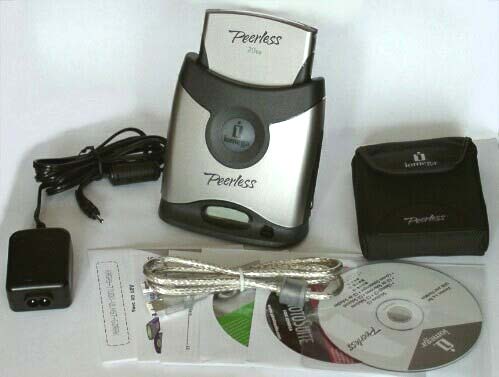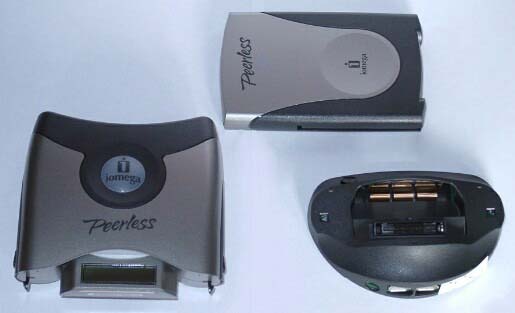The history of development of drives with removable media based on the
hard discs started with SyQuest and its drivers based on the Bernoulli
effect (when an air current resulted from disc rotation forms an air cushion
which doesn't allow magnetic heads to touch a disc surface). Later Iomega
which was famous for its ZiP drives decided to extend its sphere for the
whole range of drives with removable discs. It resulted in a new drive
named JAZ. The struggle between Iomega and SyQuest wasn't long and ended
in favor of Iomega which purchased its competitor. At almost equal speeds
and reliability Iomega offered a cheaper data storage method. Besides,
the company had a wider range of products and could carry out a more flexible
policy. The JAZ, thus, was the only drive with removable media based on
hard discs for a long time. Some time ago Castlewood released a similar
solution - ORB, but there was, in fact, nothing new. The only advantage
was that the data storage cost much decreased, but prices for JAZ cartridges
also fell down, that is why the situation was steady again. But soon the
JAZ failed to meet the requirements of all users, especially because there
was a great demand for mobile devices. And a new drive meant to replace
the JAZ was Peerless.
Peerless

Specification:
- Interface: USB 1.0, FireWire(IEEE 1394), SCSI (optional)
- HotSwap support in case of USB and FireWire
- Medium type: 10 and 20 GBytes cartridges
- Date rate: up to 15 MBytes/s
- Cartridge based on a 2.5" hard disc from IBM
- Spindle speed: 4200 RPM
- Internal data rate: 25 MBytes/s (buffer/disc)
- Average access time: 12 ms
- Typical SpinUp time: 3 s
- Shock resistance (in an idle state)
- cartridge: 400G
- drive: 200G
- Error-free running time: 250,000 hrs
We tested the drive with a FireWire(IEEE 1394) interface since
it allows using all possible capabilities of the drive. In the box
you can find the drive which consists of an interface module, a
docking station module and a cartridge, a FireWire cable (6–6),
and a power supply unit (if the FireWire controller can't
supply enough power). FireWire controllers are usually able to feed
an external device, but some models lack for such a possibility.
A FireWire controller is able to supply 15W (12V 1.25A)
to each port. And if a controller provides only 5W (12V 0.4A), it
isn't meant for feeding external modules. In the box you can also
find a case for you to wear it on your belt. And the last thing
we found here was a CD with the required tools, Iomega drivers and
software for working with photos (Photo Suite III SE) and video
(VideoWave 3.5).

Despite the stylish design of the drive, it reminds me the LEGO since it
consists of modules. A docking station module which contains control electronics
is unchangeable. An interface module and a cartridge connect to it. You
can buy separately an interface module which you need. Today you can get
USB
1.1 and FireWire modules, and SCSI and USB 2.0 will be available
later.

A cartridge is just a "jar" of an IBM 2.5" hard disc enclosed in a special
case which provides extra protection. Unlike its predecessors, this cartridge
is completely hermetic. Among other interesting things there is a speed
indicator located on the docking station and an electrical cartridge fixing
mechanism to prevent data losses during implementation of reading/recording.
Installation and operation
Installation means you have to assemble the units and connect
them to your computer. If your FireWire controller doesn't
provide enough power, then connect a power supply unit.
Iomega recommends to install the software programs before the connection,
but you can do without them. The FireWire version is much more universal
than the USB one: you don't have to take with you everywhere a CD
with drivers. Everything necessary for operation of FireWire
devices is installed during installation of the FireWire controller.
If everything is OK, the indicator will go on:

When data are transferred it starts blinking. The disc can be formatted
after it's connected. The Peerless works only with the FAT32,
and a user can't divide the cartridge disc into partitions.
The formatting of the 20 GBytes cartridge lasts 21 min. Now let's see how
good this controller works. First of all, we will test it with the Winbench99.
In case of the FireWire the interface speed mustn't be much higher than
the possibilities of the hard disc.
Winbench99
- Business Disk Winmark – 3420
- High End Disk Winmark – 10500
- Disk Transfer Rate
- Start – 17600 KBytes/s
- End – 10100 KBytes/s
- Disk Access Time – 20.5 ms
- CPU Utilization – 16.4%

Well, the FireWire interface looks excellent. Now we are going to implement
copying of files: one ~1G file and 4000 190 MBytes files.
The results are
- 1 1 GBytes file – 1m 32s
- 4000 190 MBytes files – 51s
When copying a great number of small files, the speed drops a bit, but
this is typical of many hard discs. Besides, you should remember that the
Peerless can't operate with files larger than 4 GBytes. It is not a good news
for those who want to use this drive for video capture in a real time mode.
The docking station is equipped with a indicator of copying speed, but
it is overstated, the real one is 10–15% lower.
The cartridge can be ejected from the docking station only after you
disconnected the device and pressed the button on the base, since the base
locks it. If you are trying to disconnect it incorrectly you will get a
blue screen of death both in the Windows98 and in the Windows2000.
Conclusion
High-speed USB 2.0 and FireWire interfaces will let us to
use all possibilities of the Peerless drive. Today the FireWire Peerless
is an ideal solution for working with video and audio information. Do you
want to make a full backup copy of your hard disc? No problem, it won't
take you much time, above all. The FireWire promises to become more successful
than even the USB 2.0. The market is glutted now with home
digital VCRs which have a FireWire interface for connection of digital
cameras and other similar devices.
As for downsides, there is obviously the price. I hope it will soon
drop, otherwise the Peerless won't be popular. Besides, I wish the company
developed a combined interface unit instead of two separate ones (FireWire
and USB).
Write a comment below. No registration needed!





